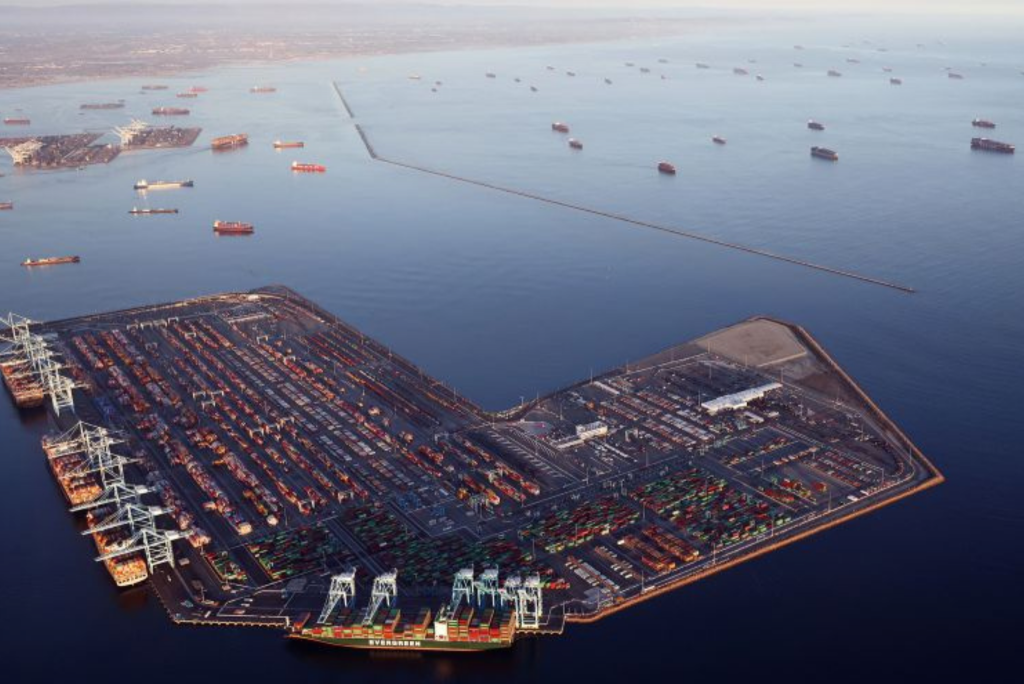Disruptions in global supply chains and a drop in demand caused by inflation are causing unprecedented issues, including a shortage of storage spaces in Southern California due to excess merchandise.
The global supply chain disruption caused by the COVID-19 pandemic is still going on. Many regions suffer product shortages as goods fail to reach their destination due to logistics issues, whereas other countries have excess merchandise piling up in warehouses. The latter issue is happening in California, where storage space is almost completely full.
Southern California became a hotspot of American foreign trade decades ago. According to data from the US Department of Commerce, 40% of the country’s imports and 25% of its exports take place in the twin ports of Los Angeles and Long Beach.

To support such trade volumes, large warehouses were built near the ports. The Southern California Association of Governments (SCAG) estimates more than 34,000 storage-related facilities are offering around 108 million square meters (1.16 billion sq. ft.) in the area.
Before the pandemic, that space was enough to store inbound and outbound goods from both ports. Now, however, logistics issues have disrupted operations, and storage space in the area is almost filled. This is because container ships from China and other Asian nations are still arriving in the US, but demand for the products they contain has waned due to inflation.
Why are warehouses in California full?
According to foreign trade data company Descartes Datamyne, imports shipped to American container ports that handle retail items from China and other countries increased over 26% in H1 2022.
The Long Beach and Los Angeles port authorities explain that during that period, they handled over 550,000 more containers than in the same period in 2021, a 10% increase, breaking a record for both ports.
‘Shipments are still flowing at a record pace, and they may not slow down in the short term,’ warned Mario Cordero, the executive director for the Port of Long Beach, adding that ‘we are preparing for a likely rise in the next few months as China exits a prolonged shutdown due to COVID-19.’
Steven Neal, president of the Long Beach Board of Harbor Commissioners, points out that ‘we are working closely with industry stakeholders to quickly take cargo off the docks and make room for the next container batch.’ However, this is compromised by the warehousing crunch.
According to experts such as Alan Amling, a professor of Supply Chains at the University of Tennessee, this situation is known as a ‘bullwhip effect:’ American companies are still making orders to stock up, but as consumers are buying less due to inflation (the US annual inflation rate is 9.1%, the highest rate in 40 years), those companies are caught between waning demand and shipments still coming from Asia. ‘We are feeling the sting of the bullwhip,’ Amling assures.
Correcting that imbalance could take months. Meanwhile, merchandise is piling up in port-adjacent warehouses. According to real estate services company Cushman & Wakefield, the number of available spaces in the Inland Empire, as the Riverside-San Bernardino-Ontario metropolitan area is known, is the lowest in America. ‘There’s a record-low 0.6% vacancy rate, compared with a national average of 3.1%,’ experts explained.
In this context, business needs for that kind of space in the region are rising every day, particularly for large retail corporations. Scott Weiss is the VP of Performance Team, a Maersk company that owns 22 warehouses in Los Angeles. According to him, ‘every time a spot opens it gets taken in a matter of seconds.’ This pushes up warehousing prices, which in turn drive inflation, hurting the US economy but benefitting industry insiders – according to data from IBIS World, the US storage market will reach $34 billion in 2022.

Potential solutions
Faced with this issue, many companies have decided to invest in the Southern California storage market. One of those companies is J.P. Morgan, which recently purchased a 42,000 square meter (452,000 sq. ft.) warehouse in the Inland Empire for $180 million. In its announcement of the purchase, the investment bank said that ‘the goal is to develop the space to make more storage room for inbound and outbound products.’
Los Angeles-based real estate investment trust Rexford Industrial Realty took a similar path; in recent weeks, its board announced the purchase of seven storage facilities for a total of $660 million, including a $417 million deal in the Inland Empire, ‘the most sought-after and least available industrial market in the country,’ as they announced.
These corporate deals align with SCAG’s vision, which means the area still has undeveloped storage spaces and lots. ‘With that, we could have an additional 31 million square meters (333.6 million sq. ft.) in space,’ the SCAG said. However, this would take time to develop and would not actually solve the current issue. Therefore, many experts claim the solution is automation.
‘We expect existing users to delve into mechanization and automation technologies and those who have not implemented these technologies yet to adopt them gradually,’ says Peter Guevarra, Director of Regional Research, Asia-Pacific, for JLL, a real estate conglomerate that provides that kind of technology.
Nevertheless, that would take time to be fully deployed, too. Because of this, a quick and efficient fix is hiring a service with professional experts capable of flexibly meeting customer demands.
Aerodoc provides that kind of service through Aerodoc Warehouse Managed Services (AWMS). This business solution allows companies to improve their competitive advantage by cutting labor costs, improving customer service, providing accurate inventory levels, and increasing flexibility and response capabilities. Moreover, Aerodoc’s professional team provides a customized solution tailored to each company’s requirements.




